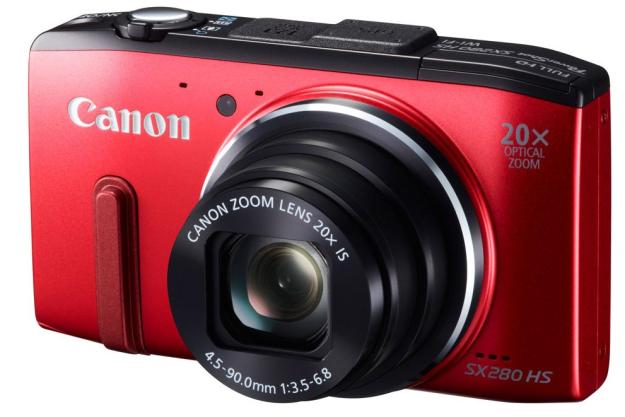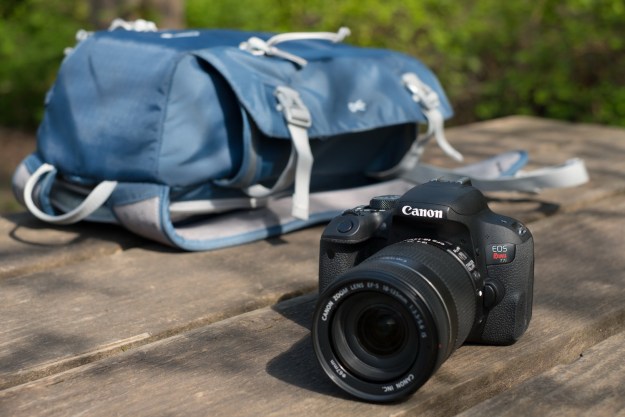
“The PowerShot SX280 HS is a powerful point-and-shoot with a strong feature-set, but isn’t without some shortcomings.”
- Powerful 20x zoom
- Sharp images in well-lit/daylight situations
- Nice autofocus performance
- Built-in Wi-Fi and GPS
- Poor placement of built-in flash
- Noisy at high ISO settings
- Barrel distortion at wide angle
As much as we hate harping on the fact that smartphone usage now accounts for a large percentage of casual photography, there are still variants of the point-and-shoot camera that can hold its own. One is the megazoom or superzoom, a camera that not only has a long zoom but also advanced shooting features.
The Canon Powershot SX280 HS is the latest in Canon’s SX line of megazooms and it comes with a slew of nice features. While the CMOS image sensor offers the same 12.1-megapixel resolution as the SX260, the SX280 is the first camera to utilize Canon’s new DIGIC 6 image processor. Canon claims that the new DIGIC 6 image processor produces less noise at higher ISO settings. Let’s see if the impressive feature list of the SX280 comes together in a complete package.
Features and design
The SX280 is a well-built camera. Its metallic body has a nice heft when you hold it. It’s available in red or black, and while it doesn’t look like a “fashion accessory” camera, the SX280 still looks good in your hand.
The front of the camera has a raised lip that provides some good support for gripping the camera with one hand. The top edge has a power button, shutter release, and zoom toggle. On the top of right side is the pop-up flash, and we had some trouble with its placement. The automatic flash pops up and down automatically depending on your settings. Unfortunately, if you’re holding the camera with two hands, it’s a bit easy for your finger to get pinched by the lowering flash. It’s more of an annoyance than anything, and after a while you’ll probably get used to it – irritating nonetheless.

The rear face of the camera features a mode dial, playback button, video recording button, four-way controller, control ring, function/settings button, and display and menu buttons. Here, we found the placement of the video recording button to be a bit dubious. We found ourselves accidentally pressing the video button repeatedly when using our thumb to rotate the mode dial and control wheel.
Dominating the rear face of the camera is the 3-inch, 461k-pixel resolution display. It’s a nice crisp display, but given the cramped fit of some of the other controls, we wonder whether or not such a large screen is always necessary. The new fad in camera design is putting the largest screen possible at the expense of the design and layout of the remaining camera controls. Unlike many new models, the SX280’s display is not touch-capable.
The SX280 has built in Wi-Fi and GPS. The Wi-Fi lets you send images to compatible wireless printers, smartphones, PCs, social media sites (via Canon’s Image Gateway portal), and even other cameras. The built-in GPS allows for easy geo-tagging of your images.
When it comes to image capture, the SX280 has a 20x zoom – 25-500mm in the 35mm equivalent. Unfortunately, only a very narrow aperture range is available – from f/3.5 to f/8 at the widest angle, to only f/6.8-f/8 at the max telephoto. The DIGIC 6 image processor allows for ISO settings from 80 through 6,400.
What’s in the box
Inside the box you’ll find the camera body, quick-start manual, camera strap, a USB cable, battery, battery charger, and Canon’s Digital Camera Solution Disk that contains software and a full manual.
Performance and use
Smartphones may be the “new” point-and-shoot camera, but when it comes to performance, a dedicated shooter like the SX280 – a megazoom, in particular – can really shine when compared to using your Android or iPhone.
Right off the bat, camera startup is almost instantaneous. When it comes to shooting, the SX280 allows continuous capture of up to 3.8 frames per second (fps) in burst mode. If the current point-and-shoot you own is several years old, you’ll really be impressed with how good the autofocus performance is in comparison. AF speed does slow down in low light, but overall, advanced point-and-shoots like the SX280 have come a long way in this department.
Smartphones may be the “new” point-and-shoot camera, but when it comes to performance, a dedicated camera like the SX280 can really shine.
One of the most identifiable features of the SX280 is its 20x zoom. By any measure, this is an impressive zoom range that allows for wide-angle shots to extreme telephoto close-ups. The lens is sharp and produces nice images all throughout the entire zoom range. This extreme zoom does come with some drawbacks. The first is that there’s noticeable barrel distortion at the widest zoom settings. This leads to some challenges when trying to capture architecture and you’re looking for straight lines. At the most telephoto range of the zoom, it becomes difficult to keep the camera steady for image capture. The built-in image stabilization does a nice job of compensating, but you have to try hard to use minute movements in order to really target a subject when fully zoomed in.
Another limitation is the small aperture range of the camera. At the wide-angle range, you’ll find f/3.5-f/8 as your available range. At the maximum zoom, you’re limited only to either f/6.8-f/8, which is very slow. Many casual users may not even notice this limitation, but for those looking for a bit more artistic control, it could be frustrating.
When it comes to noise, Canon’s DIGIC 6 image processor allows for ISO settings up to 6,400, but in real-use you may not want to. We found that ISO 800 was generally the highest setting you’ll want to go to for relatively noise-free prints and ISO 1,600 the absolute maximum. Images at ISO 3,200 and 6,400 were very noisy.
Good quality video capture is normally associated with high-end cameras but Canon has changed that (somewhat) with its DIGIC 6 image processor. The SX280 can record 1080p Full HD video at up to 60 fps, and records in the MP4 format. Video quality is smooth and the SX280 is capable of continuous autofocus. On the other side of the coin, there are still some drawbacks to shooting video on a point-and-shoot. The first is that even when shooting an outdoor street scene, the mechanical zoom noise was audible. The second was that despite the dual image stabilization mechanisms present in the SX280, it was still difficult keeping a steady hand at maximum zooms. This really speaks more to the ergonomics of trying to shoot with a superzoom on such a small camera rather than any design or functional flaws. Finally, when shooting outside on a day with moderate weather, there was a lot of wind noise in our final capture. We also found the continuous AF to be a little bit slow when zooming in and out while shooting video.
The built in Wi-Fi may be useful for some users, but you need a secondary device in order to use it. We tested it out using an Android phone and Canon’s CameraWindow app. Setup of both the camera and app was simple and straightforward, albeit a bit convoluted. Once you’re done with the setup, you can use your smartphone to view any photos stored on your camera, which you can then share to Facebook or any other service which your phone is capable of connecting to. One feature that Canon’s app lacks is the ability to remotely control your camera via a smartphone or other device. You can also set up the Wi-Fi to back up content to a computer, but we found it faster to swap the card out and plugging it into a card reader on our computer. There are other features, too, like connecting to Canon’s Image Gateway portal, which you can set up to upload photos to sites like Facebook, but it’s an experience we try to avoid.
Conclusion
When it comes to compact superzooms, Canon puts together a pretty impressive list of specs with the Powershot SX280. Cameras like this show the performance and features of advanced point-and-shoots continue to evolve and there’s still a place for them amidst the rise of cell phone photography, but still come with some drawbacks. However, for a user looking for a new point-and-shoot with a super zoom lens, the SX280 makes a nice choice.
Highs
- Powerful 20x zoom
- Sharp images in well-lit/daylight situations
- Nice autofocus performance
- Built-in Wi-Fi and GPS
Lows
- Poor placement of built-in flash
- Noisy at high ISO settings
- Barrel distortion at wide angle









